It was announced this week that the 2019 RORC Rolex Fastnet Race from Cowes will have a change of its original date, with its start moved back from Sunday, August 18th all the way to Saturday, August 3rd. W M Nixon wonders if this is the indication of bigger changes in the longterm pipeline.
It was a matter-of-fact announcement early last Monday, hidden away among the usual start-of-week newsflow items reporting the weekend’s sailing events. As far as can be discerned, it had been issued relatively unheralded as recently as 06.44 hrs on Monday morning. A trifle odd, surely, for a significant re-jigging in the calendar for a major international biennial event which is now less than 11 months away?
For the reality is that although the Fastnet Race is no longer such a big deal of endurance by comparison with the mega-events like the Volvo and Transoceanic races, for many of us it’s a very big part of our personal sailing life, and it is in turn imbued with its own almost mythic lore which continues to act as a magnet for offshore sailors worldwide, superstars and club sailors alike.
 The Fastnet’s universal and eternal attraction is captured in this dawn photo at the rock of New Zealand’s Peter Burling (left) America’s Cup winner in 2017 and Olympic Gold Medallist (49er 2016) with shipmate Ian Budgen aboard the 115ft Nikata in the Rolex Fastnet Race 2017. Photo: Ian Budgen
The Fastnet’s universal and eternal attraction is captured in this dawn photo at the rock of New Zealand’s Peter Burling (left) America’s Cup winner in 2017 and Olympic Gold Medallist (49er 2016) with shipmate Ian Budgen aboard the 115ft Nikata in the Rolex Fastnet Race 2017. Photo: Ian Budgen
So any relatively late adjustment to the Rolex Fastnet Race we now know and hold sacred is viewed with a certain suspicion, even if the change – superficially at least – seems to be no more than a 15-day change of date, which is in part dictated by tides. But in fairness, we should post the Royal Ocean Racing Club release in full, and then maybe deconstruct its true meaning with all the paranoid weaponry available to us:
“Rolex Fastnet Race 2019 – Change of Date
The 2019 edition of the Rolex Fastnet Race will start on Saturday 3rd August 2019, which is two weeks earlier than the original published date.
Unusually, the race will now run the week before Lendy Cowes Week, whose dates remain unchanged, starting on Saturday 10th August. This break with tradition, in consultation with Lendy Cowes Week, has been made for a number of reasons, including weather concerns over late August.
"We have been wrestling with this decision over the summer and particularly the relative timing with other events in Cowes and the Solent," said RORC Commodore Steven Anderson. "A late August start has weather implications for our big fleet and we anticipated running into the summer bank holiday would cause difficulty for many participants. Bringing the race forward by two weeks addresses these issues and allows us to encourage the fleet into Cowes in the pre-race days before the start.”
Commenting on the change of date RORC Racing Manager Chris Stone said:
“Bringing the race forward to Saturday 3rd August will give more time for those competitors who wish to race in Lendy Cowes Week. The prize giving in Plymouth will now be held on Thursday 8th August and this will allow competitors to make the journey back to the Solent in time to join the racing.”
More detailed information and the official Notice of Race will become available very soon on the Rolex Fastnet Race website: www.rolexfastnetrace.com”
And that’s it. No matter which way it’s read, this amounts to a major change in the structure of August’s international sailing scene. “So what?” ask most sailors. Well, for those who have done, or are thinking of doing the Rolex Fastnet Race, part of its extraordinary attraction is its history and hallowed traditions. For sure, it can be a frustrating race which has you tearing your hair out. But its mythos is such that when the Entry List is officially opened online, it is filled within minutes despite running into 350-plus boats.
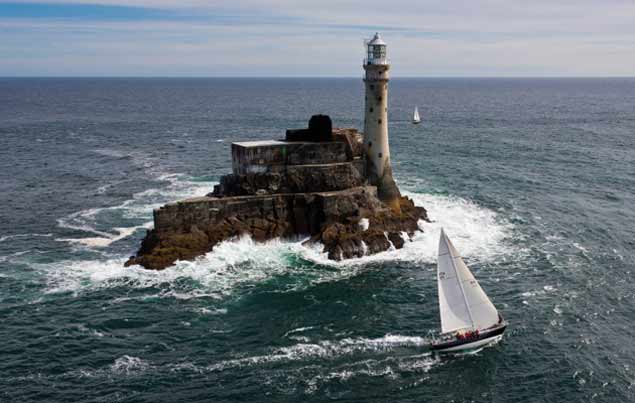 One of the boats which may be affected by the Fastnet Race change of date is the American 1969 McCurdy-designed 48ft Carina, seen here rounding the rock in 2011’s race, when she won her class. Carina was planning to return in 2019 for the Golden Jubilee of her first participation in the Fastnet, and a 15-day change in the start date will be of significance for her plans. Photo Rolex
One of the boats which may be affected by the Fastnet Race change of date is the American 1969 McCurdy-designed 48ft Carina, seen here rounding the rock in 2011’s race, when she won her class. Carina was planning to return in 2019 for the Golden Jubilee of her first participation in the Fastnet, and a 15-day change in the start date will be of significance for her plans. Photo Rolex
In fact, the Rolex Fastnet Race is so popular that, with its traditional starting time at the end of Cowes Week, the fact that Cowes is already well filled with boats racing in the Week itself means there aren’t berths available for the huge numbers shaping up to do the Fastnet, and on the start morning most of them emerge from other havens all around the Solent.
So the desire to be in Cowes for a day or two before the start is certainly acknowledged and dealt with in the new proposal. But because so many crews only join their boats a day or two before the start, and they know that it is much easier to do so on the mainland than by getting yourself across to the Isle of Wight, the attraction of this Cowes-based option is not all that it seems.
And it also carries the risk of crews being led socially astray the night before the big race. The absolutely last thing you need when starting a Fastnet Race is a hangover and a rebellious digestive tract. There’s plenty of time to party after the race is over. And if that isn’t available, you’ve the whole winter to celebrate your own personal Fastnet achievement. But on the night before the start, be sensible. And the easiest way to do that is stay out of Cowes altogether.
But beyond that, what repeatedly comes up on the message board from Fastnet veterans is straightforward: the Fastnet Race from Cowes has simply never ever started before Cowes Week. For although in the Fastnet’s early days they were very much separate events, once they became part of a shared overall programme it all seemed to be as Nature intended.
From being an innovative upstart race in 1925 which had to be started at Ryde and sent off with its seven competitors eastward out of the Solent because none of the big Cowes clubs would touch such a foolhardy venture, the Fastnet Race gradually became a “must-do” event which fitted on neatly at the end of Cowes Week and sent the growing fleet westward through the Needles Channel, an extraordinary sight with the sluicing ebb.
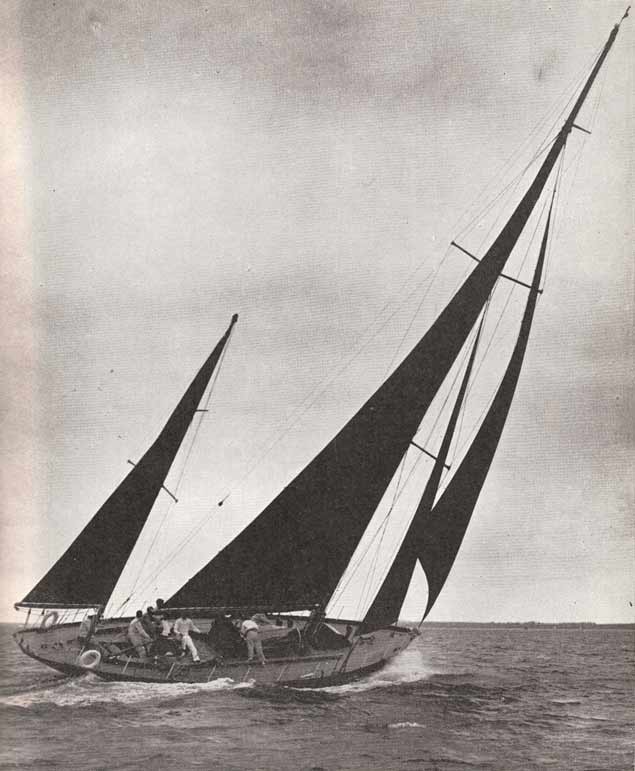 The Charles E Nicholson-designed Bloodhound, overall winner of the 1939 Fastnet Race. By this time, the Fastnet Race – first sailed in 1925 - had become a major event in the annual sailing calendar, and started from Cowes at the end of Cowes Week.
The Charles E Nicholson-designed Bloodhound, overall winner of the 1939 Fastnet Race. By this time, the Fastnet Race – first sailed in 1925 - had become a major event in the annual sailing calendar, and started from Cowes at the end of Cowes Week.
There has always been some level of Irish involvement in it from the very start, as Harry Donegan’s 17-ton cutter Gull from Cork was one of the pioneering seven in 1925, and finished third overall. And as the annual programme evolved over the years, the Fastnet’s established timing worked very well for Irish boats, as it enabled you to fit in some racing in Cowes Week, do the 603-mile Fastnet Race with its finish in Plymouth, and thus be left nicely placed to be back in Ireland before the late August gales became an increasing likelihood.
There even was a period – the Golden Years we might call them – when the boats involved really did live up to Uffa Fox’s dictum that “The best offshore racers make the best cruisers”. For in those halcyon days, offshore racers were very comfortably appointed down below, though you did try to keep weight out of the ends - but then that’s a good rule for any sailing boat including total cruisers.
Thus when an offshore race was over, you had this performance cruiser that could comfortably take you home on a proper little cruise to round out the season, and as a result there evolved the magic RORC-oriented high summer of sailing.
In this Summer of Dreams, you began sailing towards the peak of your programme with the RORC Channel Race, which started from Gosport on the Friday before Cowes Week, and put in a couple of hundred miles in a triangular course in the English Channel with the southerly turn off Cherbourg and the finish back at Gosport. Then you tootled across to Cowes where the Week was getting underway with morning service in the Parish church – “How nice to see all the old Cowes faces” as the Vicar used to start his sermon – and if you’d a Class I boat, during the Week the Britannia Cup on the Tuesday and the New York YC Cup in the Thursday were almost obligatory, after which you got ready for the Fastnet, and off you went on Saturday.
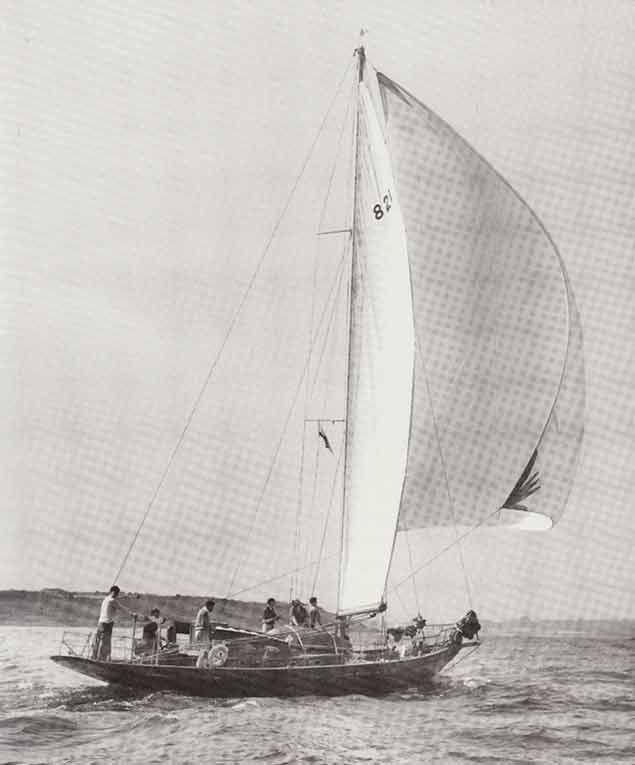 Frank & Eric Hopkirk’s 1894-built Glance (RUYC) at the start of the 1953 Fastnet Race, in which she won the Jolie Brise Cup
Frank & Eric Hopkirk’s 1894-built Glance (RUYC) at the start of the 1953 Fastnet Race, in which she won the Jolie Brise Cup
The hope was to be in Plymouth in time for the prize-giving in the Guildhall on the following Friday night, following which most Irish boats headed for home. But in the most enthusiastic years of the Corinthian era, there was even a post-Fastnet option, a RORC race from Plymouth to South Brittany or even La Rochelle to allow the possibility of some French coastal cruising before the summer was out.
By this time most folk had long since used up all their holiday time and in some cases all their money too. But a few determined hedonists, those with private means or barristers with their ludicrously long summer vacations, or perhaps stockbrokers and investors who operated on the old mantra of “Sell in May and Go Away, Come Back on St Leger Day”, they would be game for it, and in at least one year that included Frank and Eric Hopkirk from Belfast with their venerable cutter Glance and a crew of lawyers on leave.
It made for a long summer. Glance finally reappeared back in Ireland at Dunmore East sometime in September, and was left there “for collection by us next weekend”. But it took at least three weekends before the Glance crew eventually broke away from Dunmore East’s glue-pot embrace, and it was pushing November by the time she was finally hauled for the winter back at Bertie Slater’s boatyard on the shores of Ballyholme Bay.
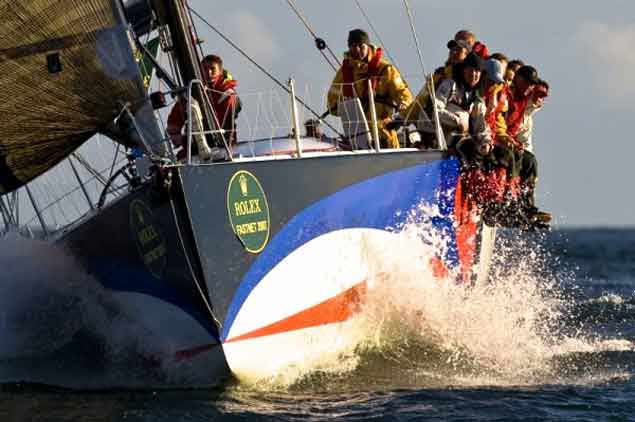 Ireland finally gets an overall Rolex Fastnet Race winner. Ger O’Rourke of Limerick’s Cookson 50 Chieftain at the finish line in Plymouth to take the supreme prize in 2007. One of Skipper O’Rourke’s first tasks ashore was to get himself a new shirt for the prize-giving. Photo: Rolex
Ireland finally gets an overall Rolex Fastnet Race winner. Ger O’Rourke of Limerick’s Cookson 50 Chieftain at the finish line in Plymouth to take the supreme prize in 2007. One of Skipper O’Rourke’s first tasks ashore was to get himself a new shirt for the prize-giving. Photo: Rolex
So when your own offshore racing years began in a place and an era when the legends of Glance and her crew still set the tone, the very idea that a valid Fastnet Race could be staged before Cowes Week would have seemed very peculiar indeed. And it still does. But the fact that it has to be contemplated shows how busy the international programme has become, and how much Cowes has moved on from being a little town which was the global focus of sailing for ten days early in August, into a place which is hiving with world class sailing for weeks on end.
And every second year, it has to cope with the unbelievable logistical challenge of choreographing a Rolex Fastnet Race start safely on its way. Visiting crews find this the most impressive thing of all until they get into the whitewater rush through the Needles Channel, and that can blow the mind. Then they add to the memory bank the rounding of the great headlands, until there’s the Fastnet Rock itself, the heart and soul and symbol of global offshore racing.
After that, the rush into Plymouth is sometimes not a rush at all, but it’s all part of the story, as is being in Plymouth itself. But the very idea that, after an inevitably hasty prize-giving on the night of Thursday 8th August 2019 in Plymouth, many crews will immediately wish to gather themselves and head for Cowes Week - that is just something that seems to fly right in the face of the natural order.
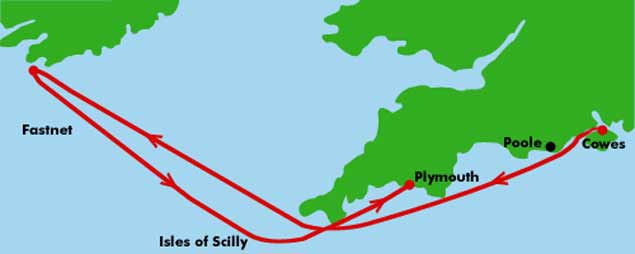 The traditional 603-mile Rolex Fastnet Race course
The traditional 603-mile Rolex Fastnet Race course
But that is probably the curmudgeonly reaction of someone who found much pleasure in the old way of doing things. And maybe it will only be for this one year – maybe in 2021 the plan is to get back to the Fastnet Race following on immediately after Cowes Week in the traditional style.
But before that happens, we’ve to get through this year’s programme, and those who plan to go on to Cowes Week from Plymouth after the Fastnet Race will inevitably ask one simple question. Why not finish the Rolex Fastnet Race in Cowes while they’re at it? After all, the RORC - in addition to its splendid main clubhouse in London - has its fully-equipped support clubhouse in Cowes, and it would be a notable economy of effort and expense to finish the Fastnet Race where it started.
It’s not a new idea by any means, but it is bound to surface again next year of all years, and it will be like a red rag to a bull for all of those who think that sailing is much too Cowes-centred for its own good in any case.
Nevertheless, the logic of it is inescapable, even if it would mean the end of the Fastnet Race as we have known it for decades. For sure, a Fastnet Race starting and finishing at Cowes would have most of the essential elements of the historic event. But for Irish crews in particular, it would never be quite the same again.
For many of us, the passage home from Plymouth was the essential final chapter, just long enough to re-adjust to the upcoming realities of ordinary life. And for those of us returning to Ireland’s East Coast, it was always something special when, after the long haul up from Land’s End, you began to get into the lee of the Wexford coast, with the hint of the scent of farmland in the air, and thistledown carrying out over the sea in the sunlit evening breeze, a reminder that summer was going fast.
 Could this become history? George David’s Rambler 88 finishes the Rolex Fastnet Race 2017 in traditional style at Plymouth. Photo Rolex
Could this become history? George David’s Rambler 88 finishes the Rolex Fastnet Race 2017 in traditional style at Plymouth. Photo Rolex
































































